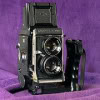so I often see guys coming into the gun shop asking how to get the scope higher off the rifle so they don't have to "lay" on the rifle in order to aim. It is IMPOSSIBLE to make them understand that the closer the scope is to the bore, the better off they will be... I understand that there are a couple extreme exceptions to this rule, but I think it is an important concept to convey. Perhaps I am just annoyed by small things, but I see this misconception far too often.. Just today a guy wanted rings for a 40mm scope that would get the scope one full inch off the bore (at the base of the rings) :banghead::banghead::banghead n a heavy barrel .22. He already had "super highs" on the gun, but still fealt he had to "lay" on the gun. This was the MAKO .22 which already has an aggressive cheek rest. anyone else frustrated by this sort of thing, or am I just too annoyed by something that is unimportant?
n a heavy barrel .22. He already had "super highs" on the gun, but still fealt he had to "lay" on the gun. This was the MAKO .22 which already has an aggressive cheek rest. anyone else frustrated by this sort of thing, or am I just too annoyed by something that is unimportant?
Last edited:




